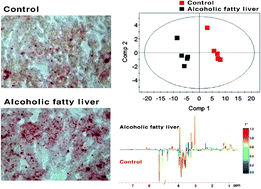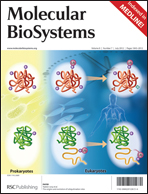Metabolic profiling of an alcoholic fatty liver in zebrafish (Danio rerio)†
Abstract
Zebrafish (Danio rerio) is becoming a popular developmental biology model to study diseases and for drug discovery. In this study, we performed proton nuclear magnetic resonance spectroscopy (1H-NMR)- and gas chromatography–mass spectrometry (GC/MS)-based metabolic profiling of an alcoholic fatty liver using a zebrafish disease model. We examined metabolic differences between the control and alcoholic fatty liver groups in zebrafish to determine how metabolism in an alcoholic fatty liver is regulated. Multivariate statistical analysis showed a significant difference between the control and alcoholic fatty liver groups. The alcoholic fatty liver group showed increased excretion of isoleucine, acetate, succinate, choline, creatine, acetoacetate, 3-hydroxybutyrate (3HB), ethyl glucuronide (EtG), lactate/pyruvate ratio, fatty acids, and cholesterol, and decreased excretion of citrate, aspartate, tyrosine, glycine, glucose, alanine, betaine, and maltose. Metabolites identified in the fatty liver groups were associated with long-term alcohol consumption, which causes both oxidation–reduction (redox) changes and oxidative stress. This study suggests that global metabolite profiling in a zebrafish model can provide insights into the metabolic changes in an alcoholic fatty liver.


 Please wait while we load your content...
Please wait while we load your content...